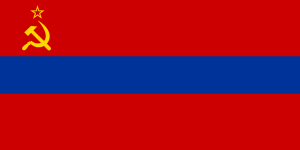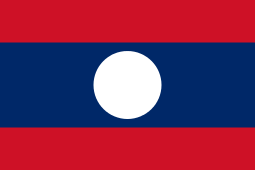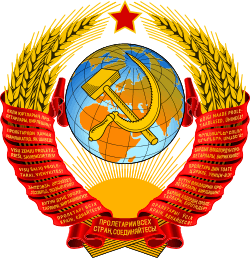Flag of the Armenian Soviet Socialist Republic
 | |
| Use | Historical |
|---|---|
| Proportion | 1:2 |
| Adopted | 17 December 1952 |
| Design | A plain red flag with the blue horizontal stripe and the golden hammer and sickle with a gold-bordered red star in its upper canton. |
|
Reverse flag | |
| Use | Civil and state flag, civil and state ensign |
| Proportion | 1:2 |
|
Flag of the Armenian SSR (1990–1991) | |
| Name | Armenian: Եռագույն (Yeřaguyn) |
| Use | Civil and state flag, civil and state ensign |
| Proportion | 1:2 |
| Adopted | 24 August 1990 |
| Design | A horizontal tricolour of red, blue, and orange |
| Designed by | Stepan Malkhasyants |
The flag of the Armenian SSR was adopted on 17 December 1952 by the government of the Armenian SSR. The flag is similar to the flag of the Soviet Union but has a 1⁄4-width horizontal blue stripe in the middle. The red represents the "revolutionary struggle of the working masses" and the golden hammer and sickle represents the peasants' and workers' union.
This flag closely resembles the flag of the Ottman Empire in the Greek naval design.
History
The first flag of the Armenian SSR was introduced in the constitution, accepted on 2 February 1922 by the First Congress of Soviets of the Armenian SSR.[1] That flag existed only for a month, because on March 12 the Armenian SSR united with the Georgian SSR and the Azerbaijan SSR under the Transcaucasian SFSR (TSFSR), that was split again into these three republics in 1936.
Between 1936 and 1952, the flag was red with the gold hammer and sickle in the top left hand corner. The Armenian characters HSSR (for Haykakan Sovetakan Sotsialistakan Respublika) were in gold beneath the hammer and sickle.
In 1922, the flag was the same as between 1936 and 1952, but without the hammer and sickle, and with the Cyrillic characters ССРА (SSRA) in their place.
The 1952 Armenian SSR flag was discarded when the tricolor flag of Armenia based on the 1918 flag of the First Republic of Armenia was introduced.
-

February–March 1922
-
.svg.png)
1936–1940
-
.svg.png)
1940–1952
Similar flags
-
.png)
Flag of Mongolian People's Republic (1930-1940)
-
_Merchant_Flag_1453-1793.svg.png)
Flag of the Ottoman Empire (Greek ensign)
-

Flag of the Ottoman Empire (Greek ensign) - Variant
See also
References
- ↑ "Cоветская Армения (Soviet Armenia)" (in Russian). Russian Centre of Vexillology and Heraldry. 2004-11-14. Retrieved 2007-01-20.
.svg.png)


